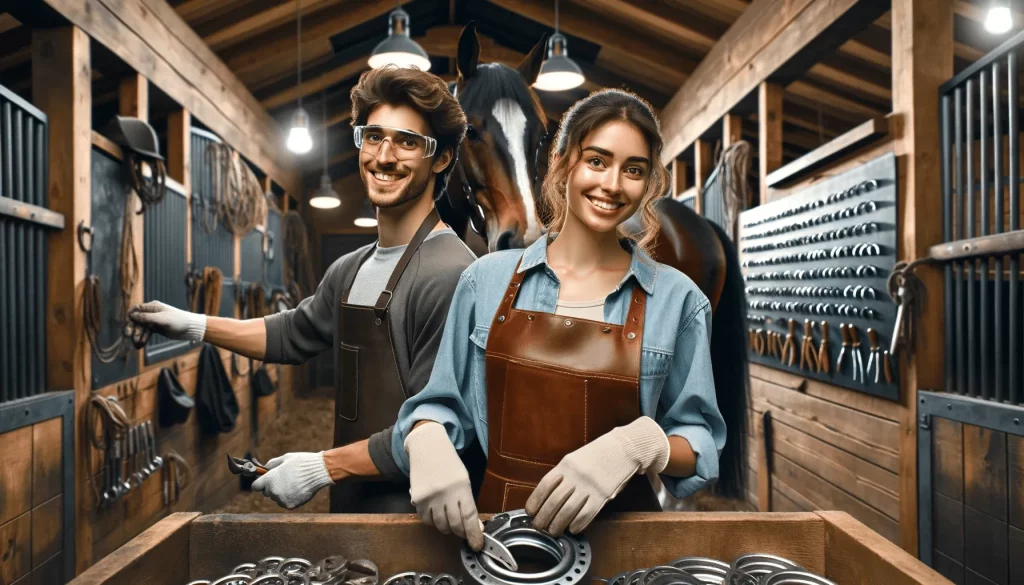Farrier Insurance
In the specialized niche of farriery, professionals combine skill, precision, and a deep understanding of equine anatomy to care for horses’ hooves, necessitating the protection that farrier insurance offers. As with any specialized trade, farrier businesses are not immune to risks.
Need
Farrier Insurance ?
Get Your Free Quote
Understanding and securing adequate insurance is crucial to protect both the practitioner and the business from unforeseen events.

This article delves into the intricacies of farrier businesses, the types of services offered, associated risks, and the various insurance coverages that provide a safety net for these unique businesses.
Understanding Farrier Businesses
A farrier business is more than just horseshoeing. It is a multifaceted enterprise that may include hoof trimming, shoeing, disease management, and hoof reconstruction. Farriers serve a vital role in the equestrian world, ensuring that horses maintain optimal hoof health, which is crucial for their overall well-being and performance.
Types of Farrier Services
Farrier services can vary greatly, ranging from basic trimming and shoeing to complex therapeutic and corrective procedures. These services may include:
| Service Type | Description |
|---|---|
| Basic Hoof Trimming and Balancing | Ensuring proper hoof length and balance for the maintenance of hoof health. |
| Shoeing | Applying metal, rubber, or synthetic shoes to protect the horse’s hooves and enhance their performance in various activities. |
| Corrective Farriery | Specialized shoeing techniques to correct hoof and limb abnormalities, often using tailored shoes or trimming methods. |
| Therapeutic Farriery | Collaborating with veterinarians to manage hoof-related diseases or injuries, potentially using specialized shoeing techniques. |
| Hot and Cold Shoeing | Hot shoeing involves shaping the heated shoe to the hoof for a custom fit, while cold shoeing adjusts pre-shaped shoes without heating. |
| Foal Hoof Care | Providing care for young horses to ensure proper hoof development and prevent future conformational issues. |
| Specialty Shoeing | Creating and applying shoes designed for horses with specific needs or conditions, such as egg-bar or heart-bar shoes. |
| Hoof Reconstruction | Rebuilding damaged hoof structures using materials like acrylics to protect and support hoof regrowth. |
| Barefoot Trimming | Maintaining the hooves of horses that do not wear shoes, ensuring they are healthy and functional. |
| Gait Analysis | Examining the horse’s movement to identify and address issues related to hoof balance or limb function. |
Risks in Farrier Businesses
Every farrier business faces inherent risks. Some examples include:
| Risk Type | Description |
|---|---|
| Injury to the Horse | Improper techniques can result in hoof or leg injuries, potentially causing long-term lameness or necessitating costly veterinary care. |
| Injury to the Farrier | The demanding job entails risks like kicks, bites, or being crushed between the horse and a hard surface, leading to serious injuries. |
| Property Damage | Work on client premises could lead to accidental damage to barns, stables, or other property, incurring liability for repairs. |
| Equipment Loss or Damage | Tools such as anvils, hammers, and nippers are expensive and can be lost, stolen, or damaged, affecting the farrier’s ability to provide services. |
| Vehicle Accidents | Regular travel increases the risk of road accidents, which can lead to injury, vehicle damage, and interruption of business activities. |
| Legal Liability | Potential lawsuits from clients if a service results in horse injury or does not meet client expectations, leading to financial and reputational harm. |
| Occupational Illness | Long-term occupational hazards include musculoskeletal disorders from repetitive motion, hearing loss from hammering, or respiratory issues from dust and forge smoke. |
| Equipment Malfunction | Reliance on equipment like forges and grinding tools which, if malfunction, can cause work delays or injuries. |
| Business Interruption | Unforeseen events like severe weather, illness, or economic downturns can disrupt business operations and income flow. |
| Animal Behavior Risk | Unpredictable behavior of horses, which can lead to sudden injuries and may not always be preventable with experience or caution. |
Farrier Liability Insurance
General Liability Insurance
General Liability Insurance is a fundamental safeguard for farrier businesses, designed to offer protection against a range of common business liabilities. This form of insurance can provide coverage in several scenarios:
Small Business General Liability Protection:
Get Your Free Quote
- Bodily Injury: If a client or a third party is injured at the farrier’s place of work—for example, if someone trips over farrier equipment left on the ground and sustains an injury—general liability insurance can cover medical expenses and legal fees if a lawsuit ensues.
- Property Damage: During the course of their work, farriers often work on client premises. If in the process of shoeing a horse, a farrier accidentally causes damage to the stable, such as breaking a fence or a barn window, general liability insurance can cover the cost of repairs.
- Advertising Injury: Farriers, like other businesses, engage in advertising. If a farrier inadvertently uses copyrighted material or a competitor’s slogan in their marketing, resulting in a legal claim of advertising injury, general liability insurance would cover legal defenses and any settlements.
Professional Liability Insurance – E&O
Professional Liability Insurance, or Errors and Omissions (E&O) Insurance, is crucial for farriers, who offer a service based on their professional expertise. This insurance is particularly important in scenarios such as:
- Service Errors: If a farrier incorrectly trims a hoof, resulting in the horse’s discomfort or lameness, the owner may claim that the farrier’s error has caused their animal pain and devalued its worth or competitiveness. E&O insurance would help the farrier handle these claims and cover the associated legal costs.
- Negligence Claims: In a case where a farrier is alleged to have not provided services to the standard expected, resulting in injury to the horse or a performance issue, the owner may file a negligence claim. Whether the farrier is at fault or not, E&O insurance can assist with the expenses involved in defending against such a claim.
- Mistaken Advice: Farriers often provide advice on hoof care. If such advice is followed and results in the horse’s injury or deteriorating condition, the owner might claim financial loss due to the farrier’s guidance. E&O insurance would be vital in covering legal fees and any compensation awarded.
In the farrier business, where the services rendered have a direct impact on the well-being of valuable animals and potentially significant investments, General Liability and Professional Liability insurances are not just beneficial but essential. They provide a financial and legal buffer against the many risks inherent in this hands-on profession.
Additional Insurance Coverages
Commercial Auto Insurance
For farriers, Commercial Auto Insurance is essential for protecting their livelihood. As they travel frequently between job sites and carry specialized equipment, the risk of road accidents or equipment damage is a real concern.
This type of insurance can cover damages resulting from collisions, theft, vandalism, and other road mishaps.
Specifically, farrier van insurance is tailored to cover the unique needs of farriers who operate vehicles that are outfitted with specialized equipment like portable forges and anvils, as well as a stock of horseshoes and nails.
This specialized coverage ensures that in the event of an incident, the farrier can recover and get back on the road without significant downtime or financial burden.
Workers’ Compensation Insurance
For farrier businesses with employees, workers’ compensation insurance is a legal requirement in most states and jurisdictions. This type of insurance offers protection for both the employee and the employer. It covers medical expenses, rehabilitation costs, and lost wages for employees who get injured while working, and it also protects the business from legal complications.
Get Your Business Insurance:
Get Your Free Quote
Example: An employee of a farrier business might suffer a broken leg after being kicked by a horse during shoeing. Workers’ compensation would cover the employee’s medical bills and a portion of their lost income during recovery.
Tools and Equipment Insurance
The specialized nature of farriery means that practitioners rely on a unique set of tools that are expensive to replace. Tools and equipment insurance ensures that a farrier can replace or repair tools that are vital to their trade without significant financial burden.
Example: A farrier’s hoof stand is damaged beyond repair when a horse spooks and steps on it. The insurance would cover the cost of replacing the stand so that the farrier can continue providing services without absorbing the cost personally.
Business Owners Policy (BOP)
A Business Owners Policy is particularly useful for small to medium-sized farrier businesses. It typically includes general liability insurance, property insurance, and business interruption insurance, among other coverages.
Example: If a fire damages a farrier’s workshop, a BOP would not only cover the damage to the workshop and replacement of equipment but also the income lost during the time the business is unable to operate.
Cyber Insurance
As more farrier businesses adopt digital tools for record-keeping, appointments, and payments, the risk of cyber incidents increases. Cyber insurance can offer protection against the consequences of digital threats such as hacking or data breaches.
Get Your Business Insurance:
Get Your Free Quote
Example: A farrier business experiences a data breach that exposes clients’ credit card information. Cyber insurance could cover the costs related to notifying clients, public relations efforts to manage the business’s reputation, and any legal costs incurred.
Commercial Property Insurance
For farrier businesses that own a brick-and-mortar location, like a farrier shop or a stable, commercial property insurance is essential. It protects the physical assets of the business against fire, theft, vandalism, and natural disasters.
Example: A severe storm causes significant damage to a farrier’s on-site workshop, including the loss of expensive horseshoe inventory. Commercial property insurance would cover the cost of repairs and replacement of the lost inventory.
Each of these insurance types is tailored to address specific risks associated with the farriery industry, ensuring that businesses can continue to operate smoothly in the face of adversity. Farriers should consult with an insurance professional to determine the appropriate level and scope of coverage for their particular operation.
Final Thoughts
In conclusion, the world of farriery is one that bridges ancient craft with modern business practices.
Farriers provide essential services that demand not only a high degree of skill and knowledge but also a deep sense of responsibility towards the wellbeing of the animals in their care.
With the range of services expanding and the complexity of risks evolving, farrier insurance has become an indispensable component of the trade.
From the protection of tools and equipment to the safeguarding against liability from accidents or professional errors, the right insurance coverage ensures the stability and longevity of a farrier’s livelihood.
As we have seen, various types of insurance, such as General Liability, Professional Liability, Commercial Auto, Workers’ Compensation, Tools and Equipment, Business Owners Policy, Cyber Insurance, and Commercial Property Insurance, offer layers of protection that cater to the unique challenges faced by farrier businesses.
Each policy has the potential to be the difference between a minor setback and a catastrophic loss.
It is paramount that farriers, akin to the care they provide for horses, also take proactive steps to secure the health and continuity of their businesses. In an era where one mishap can lead to significant financial and reputational damage, being well-insured is not just prudent; it’s a necessity.
By understanding and investing in comprehensive insurance coverage, farriers can not only protect their trade but also ensure peace of mind for themselves and their clients.
Ultimately, farrier insurance is not just about mitigating risks—it’s about empowering the professionals who dedicate their lives to this honorable profession, allowing them to work with confidence and security.
In this way, insurance doesn’t only serve as a safety net but also as a foundation for growth and prosperity in the farrier industry.

